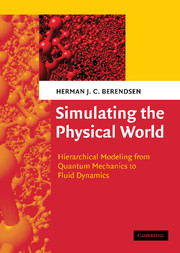Book contents
- Frontmatter
- Contents
- Preface
- Symbols, units and constants
- Part I A Modeling Hierarchy for Simulations
- 1 Introduction
- 2 Quantum mechanics: principles and relativistic effects
- 3 From quantum to classical mechanics: when and how
- 4 Quantum chemistry: solving the time-independent Schrödinger equation
- 5 Dynamics of mixed quantum/classical systems
- 6 Molecular dynamics
- 7 Free energy, entropy and potential of mean force
- 8 Stochastic dynamics: reducing degrees of freedom
- 9 Coarse graining from particles to fluid dynamics
- 10 Mesoscopic continuum dynamics
- 11 Dissipative particle dynamics
- Part II Physical and Theoretical Concepts
- References
- Index
8 - Stochastic dynamics: reducing degrees of freedom
Published online by Cambridge University Press: 05 June 2012
- Frontmatter
- Contents
- Preface
- Symbols, units and constants
- Part I A Modeling Hierarchy for Simulations
- 1 Introduction
- 2 Quantum mechanics: principles and relativistic effects
- 3 From quantum to classical mechanics: when and how
- 4 Quantum chemistry: solving the time-independent Schrödinger equation
- 5 Dynamics of mixed quantum/classical systems
- 6 Molecular dynamics
- 7 Free energy, entropy and potential of mean force
- 8 Stochastic dynamics: reducing degrees of freedom
- 9 Coarse graining from particles to fluid dynamics
- 10 Mesoscopic continuum dynamics
- 11 Dissipative particle dynamics
- Part II Physical and Theoretical Concepts
- References
- Index
Summary
Distinguishing relevant degrees of freedom
Often the interest in the behavior of large molecular systems concerns global behavior on longer time scales rather than the short-time details of local dynamics. Unfortunately, the interesting time scales and system sizes are often (far) beyond what is attainable by detailed molecular dynamics simulations. In particular, macromolecular structural relaxation (crystallization from the melt, conformational changes, polyelectrolyte condensation, protein folding, microphase separation) easily extends into the seconds range and longer. It would be desirable to simplify dynamical simulations in such a way that the “interesting” behavior is well reproduced, and in a much more efficient manner, even if this goes at the expense of “uninteresting” details. Thus we would like to reduce the number of degrees of freedom that are explicitly treated in the dynamics, but in such a way that the accuracy of global and long-time behavior is retained as much as possible.
All approaches of this type fall under the heading of coarse graining, although this term is often used in a more specific sense for models that average over local details. The relevant degrees of freedom may then either be the cartesian coordinates of special particles that represent a spatial average (the superatom approach, treated in Section 8.4), or they may be densities on a grid, defined with a certain spatial resolution. The latter type of coarse graining is treated in Chapter 9 and leads to mesoscopic continuum dynamics, treated in Chapter 10.
- Type
- Chapter
- Information
- Simulating the Physical WorldHierarchical Modeling from Quantum Mechanics to Fluid Dynamics, pp. 249 - 278Publisher: Cambridge University PressPrint publication year: 2007



